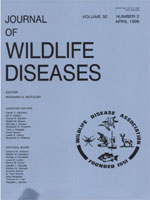Mandibular fluorine concentrations were determined in 1,425 red deer (Cervus elaphus), 240 moose (Alces alces), and 424 roe deer (Capreolus capreolus) collected in Norway from 1990 to 1993 in seven municipalities in which aluminum smelters are located, in eight neighboring municipalities, and in eight reference areas representing background levels. Background fluorine concentration was significantly correlated with age in all three species. Roe deer had the highest mean background fluorine level in each age group, followed by red deer. Due to differences in fluoride exposure, large variations in bone fluorine residues were evident between locations. In Årdal, the district most severely exposed to fluoride contamination, nine of ten cervids had fluorine concentrations exceeding background levels. The proportions of red deer with fluorine residues exceeding background levels also were high in neighboring municipalities to Årdal. We propose that roe deer are a better biomonitor of local fluoride exposure than red deer and moose, due to their more sedentary behavior.
How to translate text using browser tools
1 April 1996
FLUORIDE EXPOSURE IN CERVIDS INHABITING AREAS ADJACENT TO ALUMINUM SMELTERS IN NORWAY. I. RESIDUE LEVELS
Turid Vikøren,
Gudbrand Stuve,
Arne Frøslie

Journal of Wildlife Diseases
Vol. 32 • No. 2
April 1996
Vol. 32 • No. 2
April 1996
Alces alces
bone fluorine
Capreolus capreolus
cervids
Cervus elaphus
Fluoride emission




